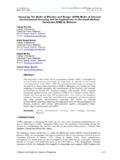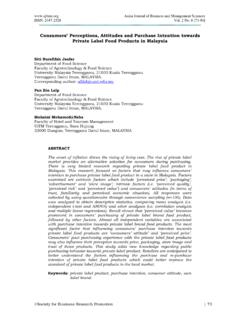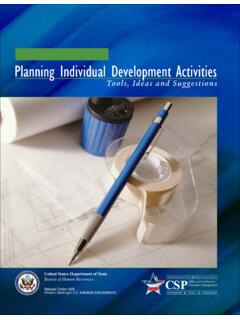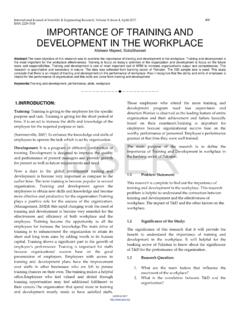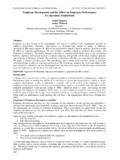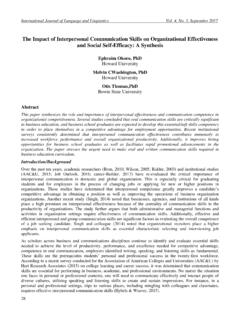Transcription of EVALUATION OF EFFECTIVENESS OF TRAINING AND …
1 Asian Journal of Business and Management Sciences ISSN: 2047-2528 Vol. 2 No. 11 [14-24] Society for Business Research Promotion | 14 EVALUATION OF EFFECTIVENESS OF TRAINING AND development : The Kirkpatrick Model AlYahya , Mohammed Saad University Utara Malaysia College of Business (UUM HRM) Malaysia . E-mail: Dr. Norsiah Binti Mat University Utara Malaysia College of Business (UUM HRM) Malaysia. E-mail: ABSTRACT EVALUATION of TRAINING EFFECTIVENESS is the measurement of improvement in the employee s knowledge, skill and behavioral pattern within the organization as a result of TRAINING program. This measurement help to match the cost incurred in the design and implementation of TRAINING with the associated benefits.
2 Thus, it indicates whether the program has been able to deliver its intended goals and objectives. The purpose of this paper is to review the model of TRAINING EFFECTIVENESS for the adoption by the human resources development executives in their planning, designing and implementation TRAINING program. INTRODUCTION TRAINING and human development activity has increase greatly over the past few decades. According to Fulmer (1988, p57), annual estimation of over $40 billion is spent on human resources development (HRD) and TRAINING in university and graduate colleges in USA. Such huge expenditure on HRD requires EVALUATION to determine the EFFECTIVENESS of TRAINING and human resource development program whether it meets its desired objectives.
3 It is very important to understand the fundamental differences between TRAINING and human resources development , this distinction is necessary when examine the methods of measuring TRAINING and human resources development . Different between TRAINING and development While measuring the EFFECTIVENESS of TRAINING and HRD, it is necessary to point out their similarities and differences with respect to improving management skill. TRAINING is generally regarded as a subset of HRD. Figure 1 indicates that TRAINING can be referred to as a structured learning experience. TRAINING activities such as seminars and workshops are normally centered on improving specific skill, whereas HRD concentrates on the improvement of all the necessary skill required by the employees of an organization to be effective.
4 However, TRAINING is regarded as a tool for HRD, on the other hand, TRAINING can be regarded as a short term activities and HRD are regarded as having long term horizon. Meanwhile, they might be defined differently but their goal and objectives are the same, their activities tend towards enhancing employees knowledge and skill for effective performance. Asian Journal of Business and Management Sciences ISSN: 2047-2528 Vol. 2 No. 11 [14-24] Society for Business Research Promotion | 15 Figure:1, Source: Gerrett & Brian (2007) Organizations whether private sector or public sector are generally agree that TRAINING and development is very critical to the growth and development of the core activities in which the organizations engages in (Noe, 2002).
5 TRAINING is an aspect of human resources development function of the organization (Rajeev et al, 2009, p272). Dessler (2005) defined TRAINING as a process that applies different methods to strengthen employees knowledge and skill needed to perform their job effectively. Other researchers on human resources development literature defined TRAINING with similar perspectives (Ivancevich, 2003; Mondy & Noe, 2005; Yong, 2003; Beardwell & Holden, 2003). Hughe (1988) perceive TRAINING as a powerful agent that brought about organizational expansion, development of capability and performance improvement. For TRAINING initiative to be effective, organization need to examine the extent to which TRAINING and HRD system closely connected with the organizational strategy, and more important, the measure to ensure the EFFECTIVENESS of TRAINING and development activities (Haslinda & Mahyidin, 2009, ).
6 The EVALUATION is carefully designed to utilize the four levels of TRAINING EFFECTIVENESS ; reaction, learning, behavior and result derived from the program (Hamid Khan, 2002, 49). Organizations are increasingly lay emphasis on the contribution of the TRAINING program to organizational strategic goal and based the EVALUATION of TRAINING as the perquisite for investment in TRAINING program. Moreover, the EFFECTIVENESS of TRAINING program in terms of its application to job is also given important consideration (Brinkerhoff, 2005). Organizations are unwilling to invest in TRAINING program that has not been sufficiently evaluated in terms of its potential contribution to the organizational strategic goals and mission, and its EFFECTIVENESS and uses on job to achieve the desired objectives (Noe & Schmitt, 1986).
7 Chang and Ho (2001) however, considered TRAINING and development as an expensive investment. They often stated that TRAINING is unnecessary because most organizations are not sure about the actual contribution of TRAINING and development toward organizational performance due to lack of EVALUATION . Furthermore, Bramley and Kitson (1994) define TRAINING as a planned effort by an organization to increase employee s learning work related competence. Employees TRAINING has become an important tools through which organization can improve its service quality, decrease labor cost and increase productivity and profitability (Kim, 2006).
8 Tracy et al, (2001) conceptualizes TRAINING EFFECTIVENESS as comprises of TRAINING acquisition and transfer of TRAINING . Transfer of TRAINING is known to be good indicators of TRAINING EFFECTIVENESS (Baldwin & Ford, 1988). Based on this, the behavioral changes that accompany TRAINING in work place could be a clear indication of TRAINING . According to Goldstein and Ford (2002) TRAINING is one of the most pervasive methods for improving job performance and enhancing employee s performance in a work environment. Kirkpatrick (2007) asserts that TRAINING is of little value to organization unless it translates into performance.
9 TRAINING EFFECTIVENESS is thus a measure of the extent to which TRAINING INITIAL PERFORMANCE Structured Experienced- TRAINING : Seminars, Conferences, Formal education. ENHANCED PERFORMANCE SELF- development COACHING COUNSELLING MENTORING Asian Journal of Business and Management Sciences ISSN: 2047-2528 Vol. 2 No. 11 [14-24] Society for Business Research Promotion | 16 achieves its intended outcome, for instance to improve work performance (Krager, Ford & Salas, 1993). From another perspective, TRAINING EVALUATION is viewed as an important component of conceptualizing, designing, analyzing, developing and implementing an effective TRAINING program (IAEA, 2003, p13).
10 Moreover, TRAINING EVALUATION has the advantage of identifying the area that needs further improvement and it may also provides an insight on methods of improvement (Goldstein & Ford, 2002). LITERATURE REVIEW Human Resources Management (HRM) literatures have described TRAINING and development as a deliberate and concerted effort that aimed at improving and enhancing organizational performance. TRAINING and development is essential for an organization to build and sustain competitive advantage in the organization s core competence. Definitely, employee s competence is specialized knowledge and skill that often enhanced by continuous TRAINING and development (Cascio, 1998; Beardwell, Holden, Claydon, 2004; Ivancevich, 2003; Mondy & Noe, 2005; Noe, Hollenbeck, Gerhardt & Wright, 2006, Yong, 2003; Torrington, Hall & Taylor, 2005).
